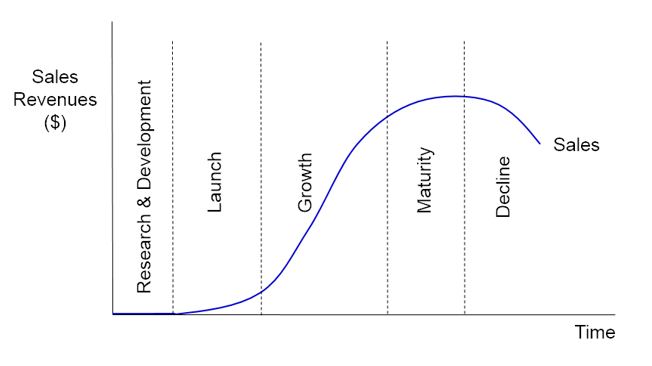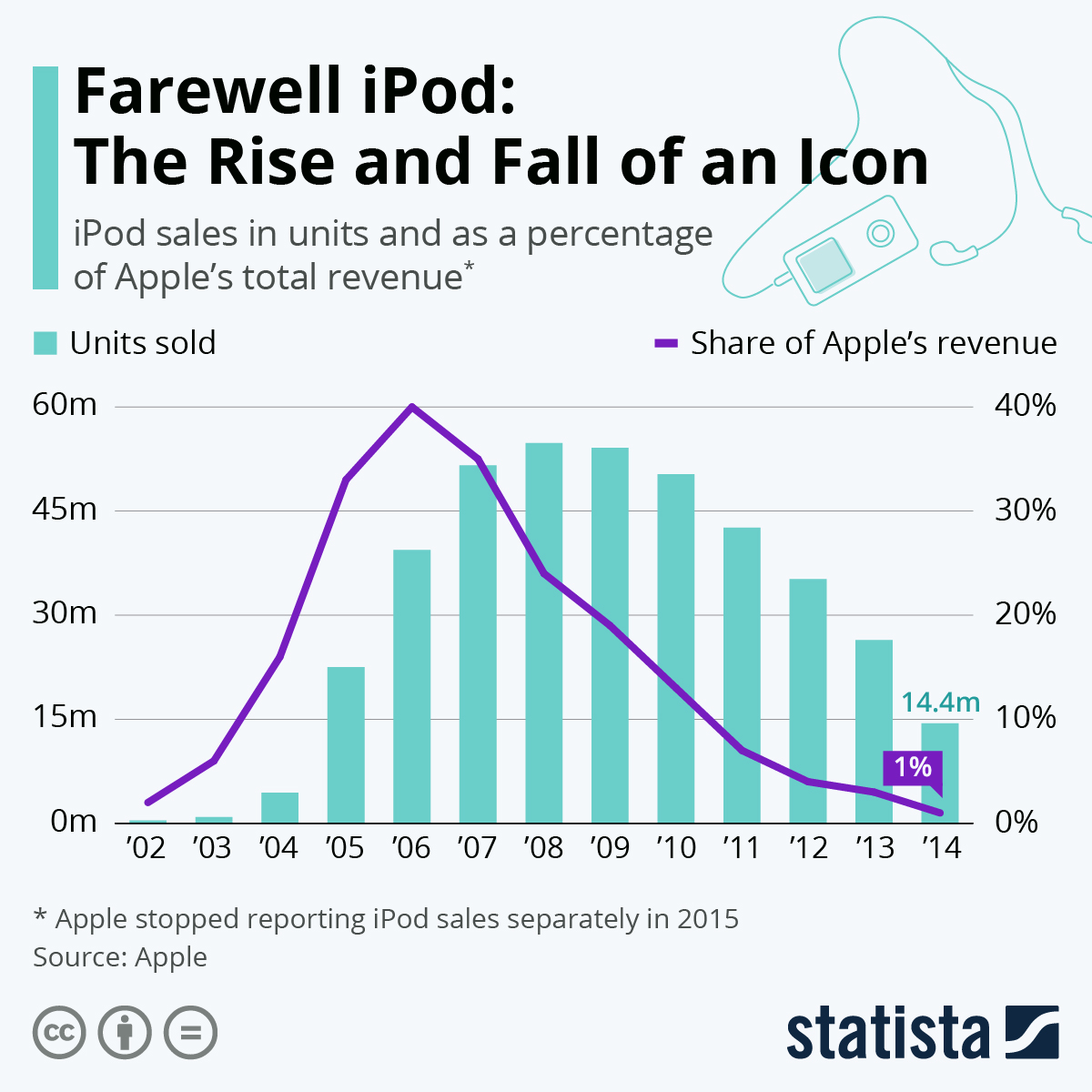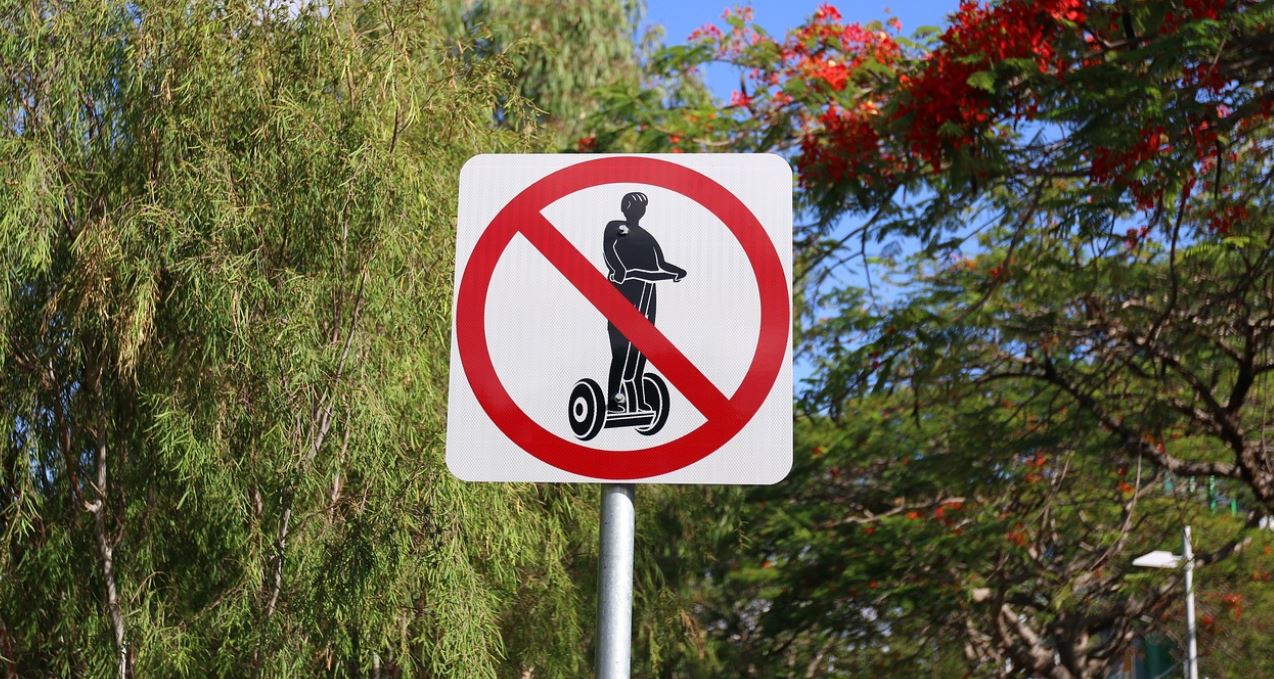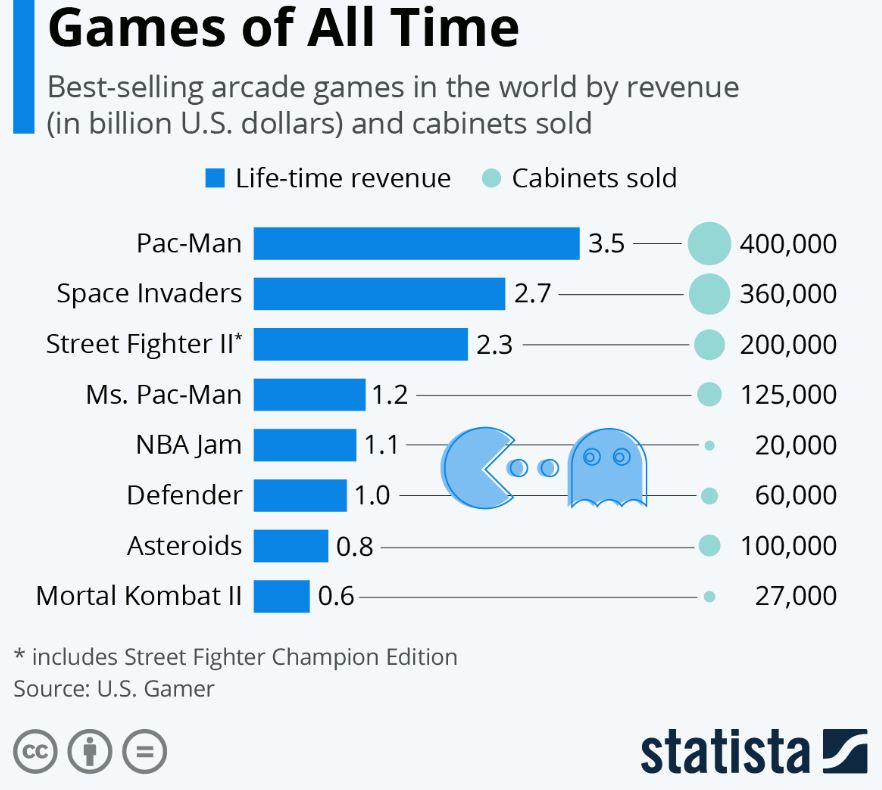The product life cycle
The product life cycle (AO2)
This section of the syllabus requires students to understand the relationship between the product life cycle, product portfolio, and the marketing mix (AO2).

A product is a physical good or intangible service provided by a business to its customers. The product life cycle (PLC) refers to a theory created by American economist Raymond Vernon in 1966. The PLC shows the different stages that (most) products go through from their research and development (R&D) stage to their final removal from the market (when there is no longer demand for the product). The PLC diagram plots the product’s sales revenue on the y-axis and the timeline along the x-axis.
The key stages of the product life cycle, as shown in the diagram above, are:
Research and development (R&D) – investigating, designing and developing a product before it is launched on the market for sale.
Launch – the product is introduced onto the market. Early adopters will buy the product, but most customers will not be aware of the new product, so advertising and promotion are vital in order to boost and sustain sales. A firm that is first on the market to launch a successful product is able to again what is known as a first mover advantage (FMA). For example, Pfizer, an American pharmaceutical giant, was able to enjoy competitive advantages, market share, and customer loyalty gained by being the first firm in an industry to successfully launch a vaccine for the coronavirus in late 2020.
Growth – sales revenue increases as the product becomes known in the market and the business gains market share. Competitors are likely to enter the market at this stage.
Maturity – sales revenue peak or plateau, as sales growth slows and the firms contend with their rivals. Sales become saturated, so the firm relies on product differentiation strategies and product extension strategies to prolong the life cycle of mature products. Firms might also strive to reposition their product to prolong sales.
Decline – sales revenue continually decline, leading to the eventual withdrawal of the product. This is usually due to changing fashions, habits and tastes or due to technological advances and R&D which make the product obsolete (outdated).
Given these different phases in a product's life cycle, it is important for managers to be aware of their product portfolio. For example, a business needs to have products in the growth and maturity stages to earn profit. This can be used to fund research and development. They also need to invest in R&D in anticipation that some products in the decline phased will be withdrawn from the market.
As a real world example, take a look at this visual stimulus of the product life cycle for Apple's iconic iPod, which was launched in 23rd October 2001 and officially withdrawn on 10th May 2022. To remain successful, Apple would need to have other products in its portfolio, knowing the sales of the iPod went into decline from around 2006. To be successful, the business would also need to ensure an appropriate marketing mix (the 7 Ps) is devised and implemented.
 Source: Statista
Source: Statista
Watch this 15-minute video clip for a detailed explanation of the product life cycle:
Case Study 1 - Products and brands with longevity
Sony’s PlayStation (1995)
Michael Jackson’s Thriller album (1982)
Rubik’s Cube (1980)
Barbie (1959)
Apple (1976)
Star Wars (1977)
Fedex (1971)
Ferrari (1971)
The Lord of the Rings (1968)
Toyota Corolla (1966)
Nike (1964)
VISA (1958)
McDonald’s (1940)
Canon (1937)
Porsche (1931)
Adidas (1924)
Walt Disney Co. (1923)
- Panasonic (1918)
BMW (1916)
L'Oréal (1909)
Chanel (1909)
Kellogg’s (1906)
Ford (1903)
Gillette (1901)
Heinz Baked Beans (1901)
Pepsi (1893)
Wrigley (1891)
Coca-Cola (1886)
HSBC (1886)
Johnson & Johnson (1886)
Levi Strauss & Co. (1853)
American Express (1850)
Cartier (1847)
Moët et Chandon champagne (1743)
Case study 2 - Products then and now
Not all brands or products have the longevity of those illustrated above. In some cases, if a product struggles to reach growth or is at the decline stage in its product life cycle, a business may choose to to re-market the product to a different audience in order to gain sales and prolonged the product's life.
Examples of products have were re-marketed in such a way include the following:
Bubble Wrap (which is actually a registered trademark) was originally marketed as wallpaper. The founders of the Sealed Air Company tried selling the product as wallpaper - but failed - and later as material for greenhouse insulation - which also failed.
Coca-Cola was originally sold by Dr. John Pemberton, a pharmacist, as a cure for morphine addiction
Similarly, 7UP was originally a mood-stabilizing drug, aimed at people with bipolar disorder. According to The New York Times, "7" refers to lithium's atomic mass (lithium was used in the drink until 1950) and "UP" refers to the improved mood following consumption of the drink.
The first Colgate products were candles and soap.
Frisbees (which are also a registered trademark) were originally used as tinned pie containers. The Frisbie Pie Company was founded in 1871 by William Russell Frisbie. Yale University students discovered an alternative use for the tins, and the rest is history.
Lamborghini made tractors long before the company made super sports cars.
Listerine started out as an anti-septic for cleaning floors and a cure for Gonorrhoea (bacterial discharge). According to Freakonomics, sales of Listerine rose from $115,000 to more than $8 million in the first seven years after the change of product strategy (that's more than 6,856% growth).
Peanut butter was originally use as a protein supplement for people with poor teeth so could not chew meat.
Play-Doh was originally a product used to clean soot and dirt off wallpaper.
Super Glue (yet another registered trademark) was once utilised as an emergency wound-sealer in wars, especially the Vietnam War, before it became used as a common household product by the general public.
Tiffany & Co. was associated with stationery products long before the company became known for its jewellery products.
Viagra was originally designed to lower blood pressure and treat Angina - a common heart problem which reduces blood flow to the heart thereby causing chest pains.
Wrigley’s made soap and baking powder products before the brand became associated with chewing gum.
The relationship between the PLC and the marketing mix
.jpg)
It is important for a business to stay up to date with market changes and trends. Marketing myopia exists when a business becomes complacent (care-free, reckless, or unaware of danger signals) about its product strategy, thereby failing to retain any competitive advantage in the market.
The marketing mix for a product will change depending on the specific stage of the product life cycle (PLC) that is being examined. The section below outlines some generic examples of this.
Research & Development (pre-launch)
Market research conducted to discover what products would appeal to potential customers.
Creating prototypes and test marketing activities.
Discussion with key stakeholders about pricing, packaging, promotion and distribution prior to launching the product.
There are no sales during this phase of the product life cycle, but expenditure will be high.
Investment costs will be very high (especially for R&D), profit will be negative, and cash flow will be negative.

Developing a prototype is part of the PLC
Introduction (launch)
A promotional mix is used to raise awareness of the product (a question mark in the Boston Matrix), e.g. advertising, point of sale promotion, direct mail and sales promotions.
A high price might be set in an attempt to recoup the costs of R&D, especially if there is very limited competition in market. Alternatively, for some products, a low price might be more suitable in order for the business to establish itself in an existing market and/or to gain market share.
There are limited distribution channels as the product is targeted at early adopters and most customers are not (fully) aware of the product. Hence, it is unlikely that the product is profitable at this stage.
Marketing expenditure will be high in order to raise the profile of the product and to generate sales growth.
Investment costs will be high (especially for marketing), profit will be negative, and cash flow will be negative but more favourable as the product gets noticed.
Watch this video showing Steve Jobs launching the very first iPhone back in 2007:
ATL Activity 1 - Apple’s iPod
Read this case study from The Economist, and answer the questions that follow about how Apple’s iPod revolutionised the digital music industry.
Questions
When did Steve Jobs reveal the first iPod?
How many songs could the original iPod’s hard drive hold?
What was the price of the iPod at launch?
By 2007, how many iPods had been sold?
At its peak, what percentage of Apple’s sales revenue came from the iPod?
In which country was Spotify founded?
What percentage of music sales in the USA are accountable for by streaming platforms such as Spotify?
When did Apple launch its iconic iPhone, which ultimately superseded the iPod?
Answers
When did Steve Jobs reveal the first iPod?
23rd October 2001How many songs could the original iPod’s hard drive hold?
Enough for 1,000 songsWhat was the price of the iPod at launch?
$399 (about $580 today)By 2007, how many iPods had been sold?
120 million (that’s about 54,795 iPods sold every day in its first 6 years!)At its peak, what percentage of Apple’s sales revenue came from the iPod?
40%In which country was Spotify founded?
SwedenWhat percentage of music sales in the USA are accountable for by streaming platforms such as Spotify?
Nearly 80%When did Apple launch its iconic iPhone, which ultimately superseded the iPod?
Late 2007
Watch this video clip to see Steve Jobs launching the iPod back in 2001:
Growth
Sales revenue increases as marketing efforts make the product and brand known to the market. The rising star is likely to be earning profit for the business at this stage.
The larger customer base warrants a larger number of distribution channels.
The marketing mix focuses on product development (improvements to the product), brand preference (with the aim of getting potential customers to switch from competing brands) and customer loyalty.
Pricing strategy may need to change due to competition in the market and to facilitate continued growth.
Investment costs will be high (especially for marketing purposes), profit will materialise, and cash flow will be positive as product recognition and sales grow.
Maturity
Marketing is extensive and the product is well known in the market.
The marketing mix focuses on keeping the product as a cash cow for as long as possible in order to maximize profits. Profit will be high and generally stable.
Brand loyalty and brand value are vital aspects of product differentiation in order to prolong this stage of the life cycle.
There is also price competition as the product competes in a mature market with well-established suppliers.
Extension strategies may be required in order to lengthen the product’s life cycle. Examples include adding new features to the product or launching a limited edition to spark renewed interest.
Investment costs will be low as the product become well-established and mature, profit will be peak, and cash flow remain positive.
Decline
This is the final stage in a product’s life cycle, with products eventually becoming dogs (products with low market share in declining markets). Customers have lost interest in the product at this stage of its life cycle.
Prices need to be lowered in order to sell such products, especially those that are obsolete (outdated) and are soon to be replaced with newer models.
Businesses need to decide whether (and for how long) to continue marketing the product or to withdraw it from the market.
Profits drop at this stage, and financial losses might be incurred.
Divestment is likely to occur at some point during this stage as profits drop at this stage (financial losses might even be incurred). Cash flow is likely to become negative.
Watch this 9 minute video to consolidate and review your understanding of the product life cycle:
Key concepts - Change and Creativity
Use real world examples to discuss how change and creativity have impacted the product life cycle for different businesses.
Case Study 3 - The decline of compact discs
The launch of MP3 players, the iPod and online file sharing in the early 2000s have caused the continued plummeting of CD sales in the USA and around the world. According to the Recording Industry Association of America (RIAA), CD sales nearly halved between 2000 and 2007. CD album sales in the United States have declined by more than 95 per cent since 2000 (when sales peaked).
The chart from Statista shows that CD sales have declined below the level since 1986. Back then, Whitney Houston's debut album topped the Billboard CD charts. Since the launch of the iPhone (and other smartphones that followed) plus digital music streaming services, the CD as a product is in its final phase of the product life cycle.

Source: Statista
Case Study 4 - Volkswagen Group
For a real-life example, watch this video clip from Business Insider about the rise and fall of the iconic Volkswagen Beetle. The car enjoyed over eight decades of production before the final VW Beetle was rolled off the production line in Puebla, Mexico in 2019:
ATL Activity 2 - The Segway

Read this BBC article titled "Segway: End of the road for the much-hyped two-wheeler", about the withdrawal of the Segway in 2020, by clicking the link here.
Questions
When was the Segway first launched?
Who invented the Segway?
When did production of the Segway end?
In which 2009 comedy movie was the Segway famously featured in?
What was the main reason for the decline of Segways?
What happened to Usain Bolt, the record-breaking Olympic athlete, in 2015?
Who was Jimi Heselden?
What happened to Jimi Heselden just 10 months after buying the firm?
Where did Segway debut the S-Pod, the company's prototype of its wheelchair?
What happened to the prototype wheelchair when it was being debuted?
Answers
When was the Segway first launched?
2001Who invented the Segway?
Dean KamenWhen did production of the Segway end?
15th July, 2020In which 2009 comedy movie was the Segway famously featured in?
Paul Blart: Mall CopWhat was the main reason for the decline of Segways?
They have also been the subject of mockery as well as high-profile collisions including a tragic deathWhat happened to Usain Bolt, the record-breaking Olympic athlete, in 2015?
He collided with a cameraman while doing his 4th consecutive World 200m title raceWho was Jimi Heselden?
The owner and self-made millionaire of the Segway company, which he bought outright in 2009What happened to Jimi Heselden just 10 months after buying the firm?
He tragically died from falling off a cliff in the UK whilst using one of his Segways motorised scootersWhere did Segway debut the S-Pod, the company's prototype of its wheelchair?
The Consumer Electronics Show (CES) exhibition in Las Vegas (Nevada, USA)What happened to the prototype wheelchair when it was being debuted?
The S-Pod - a self-balancing electric wheelchair - was being tested by a journalist at the time, who had accelerated the vehicle before accidently crashing into a wall
ATL Activity 3 - The longevity of arcade games
Which arcade game do you think is the best-selling product of all time? Read this article from Statista to find out if you were correct. Answer these questions from the article.
Questions
1. How old was Pac-Man in May 2020?
2. Which Japanese company developed Pac-Man?
3. What was the value of sales of Pac-Man by 1990?
4. Why did Pac-Man become popular with female players?
5. What was the name of the spin-off of the Pac-Man game and was it also a hit?
6. Name the top 5 arcade games, according to the article.
Answers
The best-selling arcade game of all time is Pac-Man...

1. How old was Pac-Man in May 2020?
40 years old
2. Which Japanese company developed Pac-Man?
Namco
3. What was the value of sales of Pac-Man by 1990?
$3.5 billion - not many arcade games can claim to be multi-billion dollar products three decades on
4. Why did Pac-Man become popular with female players?
Pac-Man is credited as a pioneering non-violent arcade gameplay, unlike Street Fighter and Mortal Kombat.
5. What was the name of the spin-off of the Pac-Man game and was it also a hit?
Ms. Pac-Man; yes, according to US Gamer, Ms. Pac-Man was also a huge hit and made the top 5 of the best-selling arcade games
6. Name the top 5 arcade games, according to the article.
Pac-Man, Space Invaders, Street Fighter II, Ms. Pac-Man, and NBA Jam.
Business Management Toolkit
Explain how Ansoff’s matrix can be used to understand the risks associated with a new product launch.
Business Management Toolkit
Discuss how knowledge of the Boston Consulting Group matrix helps marketing managers to gain a better understanding of the relationship between the product life cycle, product portfolio, and the marketing mix. Use real world examples in your answers.
Decline is the final phase in the PLC when sales revenue continually fall, leading to the eventual withdrawal of the product from the market.
A first mover advantage (FMA) describes a business being first in the market to launch a successful product, thereby gaining market share and establishing a loyal customer base.
Growth is a phase in the PLC when sales revenue increases as the product becomes established in the market and the business gains market share. Competitors are likely to enter the market at this stage.
Launch is a phase in the PLC that involves a product being introduced in the market. Most customers are not aware of the new product, so advertising and promotion are needed to boost and sustain sales.
Marketing myopia exists when a business becomes complacent about its product strategy, so does not keep up with market trends and changes.
Maturity is a phase in the PLC when sales revenue peak or plateau, as sales growth slows down and the business competes with its rivals in the market.
The product life cycle (PLC) shows the different stages that products typically go through from their R&D stage to their final removal from the market.
Research and development (R&D) is the first phase in the PLC which involves investigating, designing, and developing a product before it is launched in the market.
Return to the Unit 4.5 - Product homepage
Return to the Unit 4 - Marketing homepage
 IB Docs (2) Team
IB Docs (2) Team
